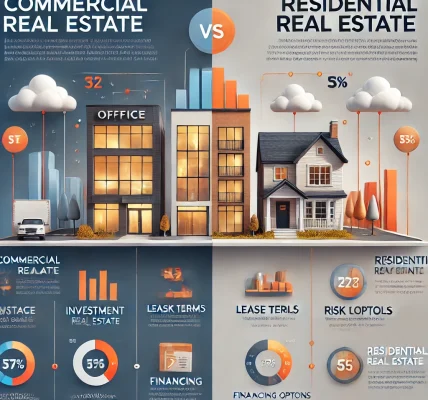Introduction
Investing in real estate has traditionally required large capital, property management skills, and active involvement. But with real estate crowdfunding, you can now invest in lucrative properties with small amounts of money, completely passively.
This beginner-friendly DIY guide will walk you through:
✅ What real estate crowdfunding is and how it works.
✅ The types of crowdfunding investments available.
✅ The benefits and risks associated with this strategy.
✅ A step-by-step guide to getting started safely.
If you’re looking for a way to build wealth through real estate without owning property, this guide is for you!
1. What is Real Estate Crowdfunding?
Real estate crowdfunding is an investment model where multiple investors pool their money to fund a real estate project. Instead of buying an entire property yourself, you invest in a fraction of a project, sharing both the profits and risks with other investors.
How It Works
✔️ A real estate developer lists a project on a crowdfunding platform.
✔️ Investors contribute capital to fund the project.
✔️ The property is developed, rented, or sold for profit.
✔️ Investors earn returns through rental income or appreciation.
Popular crowdfunding platforms include:
🔹 Fundrise – Ideal for beginners.
🔹 RealtyMogul – Best for commercial real estate investments.
🔹 CrowdStreet – Great for high-net-worth individuals.
🔹 Yieldstreet – Offers alternative real estate investments.
2. Types of Real Estate Crowdfunding Investments
Crowdfunding investments typically fall into two categories:
A. Equity Crowdfunding (Ownership-Based Investment)
🔹 Investors own a share in a real estate project.
🔹 Returns come from rental income and property appreciation.
🔹 Higher potential profits but also higher risks.
✅ Best for: Long-term investors looking for passive income.
B. Debt Crowdfunding (Loan-Based Investment)
🔹 Investors lend money to real estate developers.
🔹 Returns come from fixed interest payments (like a bank loan).
🔹 Lower risk, but returns are capped at fixed interest rates.
✅ Best for: Investors seeking stable, predictable income.
3. Benefits of Real Estate Crowdfunding
🏆 1. Low Capital Requirement
Unlike buying physical property, crowdfunding allows you to invest with as little as $500-$1,000.
📈 2. Passive Income
No need to manage tenants, repairs, or paperwork—the platform and real estate operators handle everything.
🌍 3. Diversification
Invest in multiple properties across different cities or asset types (residential, commercial, industrial) to reduce risk.
🔄 4. Liquidity Options
Some platforms offer secondary markets, allowing you to sell your shares if you need to exit early.
🏢 5. Access to Premium Real Estate
Gain exposure to luxury hotels, office buildings, and commercial properties usually reserved for high-net-worth investors.
4. Risks of Real Estate Crowdfunding (and How to Mitigate Them)
While crowdfunding offers great opportunities, it’s important to be aware of the risks:
❌ 1. Market Risk
Real estate prices can fluctuate due to economic downturns or local market conditions.
✅ Mitigation: Invest in diverse locations and property types to spread risk.
❌ 2. Platform Risk
Some crowdfunding platforms may have poor track records or lack financial stability.
✅ Mitigation: Choose well-established platforms with strong investor reviews.
❌ 3. Liquidity Constraints
Unlike stocks, most real estate investments are long-term (5+ years).
✅ Mitigation: Only invest money you won’t need immediately.
❌ 4. Project Failure
If a real estate project underperforms, investors might lose money.
✅ Mitigation: Review the developer’s track record and risk factors before investing.
5. How to Get Started with Real Estate Crowdfunding (A DIY Guide)
Step 1: Choose a Reputable Crowdfunding Platform
📌 Compare platforms like Fundrise, RealtyMogul, and CrowdStreet based on:
✔️ Minimum investment requirements.
✔️ Property types and locations.
✔️ Expected ROI and fees.
Step 2: Decide Between Equity or Debt Investment
📌 Ask yourself:
- Do I want higher risk but bigger rewards? → Go for equity investments.
- Do I want stable, fixed returns? → Go for debt investments.
Step 3: Diversify Your Portfolio
📌 Don’t put all your money into one property or one city. Instead, invest in:
- Residential apartments (steady rental income).
- Commercial properties (higher long-term appreciation).
- Mixed-use developments (balanced risk-reward).
Step 4: Review Investment Terms & Fees
📌 Always check:
✔️ Projected returns (ROI).
✔️ Platform fees (management or performance-based).
✔️ Investment lock-in period (how long your money will be tied up).
Step 5: Start Small & Monitor Performance
📌 If you’re new, start with $500-$1,000, then reinvest profits.
📌 Use platform dashboards to track your investments.
6. Who Should Invest in Real Estate Crowdfunding?
This investment strategy is ideal for:
✔️ Busy professionals who want passive income.
✔️ New investors with limited capital.
✔️ Retirees seeking stable, long-term returns.
✔️ Tech-savvy investors comfortable using online platforms.
Not ideal for:
❌ Those looking for quick cash (real estate is a long-term game).
❌ Investors who need immediate liquidity.
Conclusion: Is Real Estate Crowdfunding Right for You?
Real estate crowdfunding offers a low-cost, passive way to invest in property without the headaches of traditional ownership.
Key Takeaways:
✔️ Invest with as little as $500 on top platforms.
✔️ Choose between equity (higher risk/reward) or debt (stable returns).
✔️ Diversify across multiple properties for lower risk.
✔️ Always review platform fees, ROI, and lock-in periods before investing.
By following this DIY guide, you can start building wealth through real estate with minimal effort.
Final Thought:
Are you ready to start investing in real estate crowdfunding? Drop your questions in the comments below!




